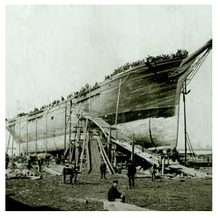American shipbuilder From Wikipedia, the free encyclopedia
Donald McKay (September 4, 1810 – September 20, 1880) was a Nova Scotian-born American designer and builder of sailing ships, famed for his record-setting extreme clippers.
Donald McKay | |
|---|---|
 | |
| Born | September 4, 1810 Jordan Falls, Shelburne County, Colony of Nova Scotia |
| Died | September 20, 1880 (aged 70) |
| Occupation | Ship Designer |
| Known for | Flying Cloud |
| Spouse(s) | Albenia Boole (married 1833–1848, until her death) and Mary Cressy Litchfield (m.1850) |
McKay was born in Jordan Falls, Shelburne County, on Nova Scotia's South Shore, the oldest son and one of eighteen children of Hugh McKay, a fisherman and a farmer, and Ann McPherson McKay. Both of his parents were of Scottish descent. He was named after his grandfather, Captain Donald McKay, a British officer, who after the Revolutionary war moved to Nova Scotia from the Scottish Highlands.[1]
In 1826 McKay moved to New York, where he served his apprenticeship under Isaac Webb in the Webb & Allen shipyard from 1827 to 1831.[1][2] He then returned briefly to Nova Scotia and built a boat with his uncle, but after they were swindled from the proceeds he returned to New York and took a job in the Brown & Bell shipyard, working for Jacob Bell.[3] In 1840, following a recommendation from Bell, he was taken on as a supervisor at the Brooklyn Navy Yard, but stayed only briefly because of the anti-immigrant sentiment towards him (as a Canadian) from the men he was supervising.[3] Bell came to the rescue and found him an assignment to work on a packet ship in a shipyard in Wiscasset, Maine. Returning south when that assignment was complete, he stopped in Newburyport and took a job as a foreman in the yard of John Currier, Jr.,[4] where he supervised the construction of the 427-ton Delia Walker. Currier was very impressed with McKay and offered him a five-year contract, which McKay refused driven by desire to own his own business.[5]
In 1841, William Currier (no relation to John) offered McKay the chance to become a partner in what would become the Currier & McKay shipyard in Newburyport. Two years later, with McKay now designing ships on his own, he and Currier parted ways and McKay went into business with a man named William Picket, building the packet ships St. George and John R. Skiddy. The partnership with Picket was "pleasant and profitable", but after McKay built the Joshua Bates for Enoch Train's new packet line to Liverpool in 1844, Train persuaded him to move to East Boston and start his own shipyard there.[3][5] Train not only provided the financing for McKay to do this but then became his biggest customer, commissioning seven more packet ships and four clipper ships between 1845 and 1853—including the legendary extreme clipper Flying Cloud.[3]

In 1845 McKay, as a sole owner, established his own shipyard on Border Street, East Boston, where he built some of the finest American ships over a career of almost 25 years.
One of his first large orders was building five large packet ships for Enoch Train's White Diamond line between 1845 and 1850: Washington Irving, Anglo Saxon, Anglo American, Daniel Webster, and Ocean Monarch.[8] The Ocean Monarch was lost to fire on August 28, 1848, soon after leaving Liverpool and within sight of Wales; over 170 of the passengers and crew perished.[9] The Washington Irving carried Patrick Kennedy, grandfather of Kennedy family patriarch Joseph P. Kennedy Sr., to Boston in 1849.
In the summer of 1851, McKay visited Liverpool and secured a contract to build four large ships for James Baines & Co.'s Australian trade: Lightning (1854), Champion of the Seas (1854), James Baines (1854), and Donald McKay (1855).[10]



In 1869, under financial pressure from previous losses, McKay sold his shipyard and worked for some time in other shipyards. He retired to his farm near Hamilton, Massachusetts, spending the rest of his life there. He died in 1880 in relative poverty and was buried in Newburyport.[1]
McKay's designs were characterized by a long fine bow with increasing hollow and waterlines. He was perhaps influenced by the writings of John W. Griffiths, designer of the China clipper Rainbow in 1845. The long hollow bow helped to penetrate rather than ride over the wave produced by the hull at high speeds, reducing resistance as hull speed is approached. Hull speed is the natural speed of a wave the same length as the ship, in knots, , where LWL = Length of Water Line in feet. His hulls had a shorter afterbody, putting the center of buoyancy farther aft than was typical of the period, as well as a full midsection with rather flat bottom. These characteristics led to lower drag at high speed compared to other ships of similar length, as well as great stability which translated into the ability to carry sail in high winds (more power in extreme conditions). His fishing schooner design was even more radical than his clippers, being a huge flat-bottomed dinghy similar in form to 20th century planing boats. These design changes were not favorable for light wind conditions such as were expected on the China trade, but were profitable in the California and Australian trades.
Pan Am named one of their Boeing 747s Clipper Donald McKay in his honor.
There is a monument to McKay in South Boston, near Fort Independence, overlooking the channel, that lists all his ships. There were more than thirty ships listed.
His house in East Boston was designated a Boston Landmark in 1977[27] and is also on the National Register of Historic Places.
A memorial pavilion to McKay, including a painting of his famous "Flying Cloud", can be found at Piers Park in East Boston.
McKay was inducted into the National Sailing Hall of Fame on November 9, 2019.[28]
Seamless Wikipedia browsing. On steroids.